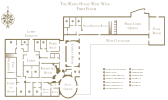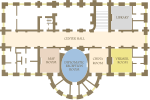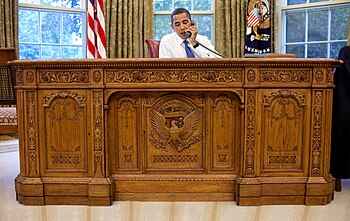From Wikipedia, the free encyclopedia
(Redirected from White house)
For other uses, see White House (disambiguation).
See also: Executive Office of the President of the United States and List of residences of Presidents of the United States
| The White House | |
|---|---|
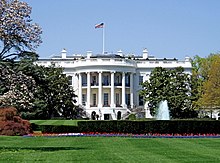
The South Portico of the White House in May 2006.
|
|
|
|
|
| General information | |
| Architectural style | Neoclassical, Palladian |
| Location | 1600 Pennsylvania Avenue NW Washington, D.C. 20500 U.S. |
| Coordinates | 38°53′51.61″N 77°2′11.58″W / 38.8976694°N 77.0365500°W |
| Current tenants | Barack Obama, President of the United States and the First Family |
| Construction started |
‹See Tfd› October 13, 1792 |
| Design and construction | |
| Architect | James Hoban |
The house was designed by Irish-born James Hoban,[1] and built between 1792 and 1800 of white-painted Aquia Creek sandstone in the Neoclassical style. When Thomas Jefferson moved into the house in 1801, he (with architect Benjamin Henry Latrobe) expanded the building outward, creating two colonnades that were meant to conceal stables and storage.[2]
In 1814, during the War of 1812, the mansion was set ablaze by the British Army in the Burning of Washington, destroying the interior and charring much of the exterior. Reconstruction began almost immediately, and President James Monroe moved into the partially reconstructed Executive Residence in October 1817. Construction continued with the addition of the South Portico in 1824 and the North in 1829.
Because of crowding within the executive mansion itself, President Theodore Roosevelt had all work offices relocated to the newly constructed West Wing in 1901. Eight years later, President William Howard Taft expanded the West Wing and created the first Oval Office which was eventually moved as the section was expanded. The third-floor attic was converted to living quarters in 1927 by augmenting the existing hip roof with long shed dormers. A newly constructed East Wing was used as a reception area for social events; Jefferson's colonnades connected the new wings.
East Wing alterations were completed in 1946, creating additional office space. By 1948, the house's load-bearing exterior walls and internal wood beams were found to be close to failure. Under Harry S. Truman, the interior rooms were completely dismantled and a new internal load-bearing steel frame constructed inside the walls. Once this work was completed, the interior rooms were rebuilt.
Today, the White House Complex includes the Executive Residence, West Wing, East Wing, the Eisenhower Executive Office Building—the former State Department, which now houses offices for the President's staff and the Vice President—and Blair House, a guest residence.
The Executive Residence is made up of six stories—the Ground Floor, State Floor, Second Floor, and Third Floor, as well as a two-story basement. The term White House is regularly used as a metonym for the Executive Office of the President of the United States and for the president's administration and advisers in general. The property is a National Heritage Site owned by the National Park Service and is part of the President's Park. In 2007, it was ranked second on the American Institute of Architects list of "America's Favorite Architecture".
Contents
[hide]History
1789–1800
Following his April 1789 inauguration, President George Washington occupied two executive mansions in New York City: the Samuel Osgood House at 3 Cherry Street (April 1789 – February 1790), and the Alexander Macomb House at 39–41 Broadway (February–August 1790).The July 1790 Residence Act named Philadelphia, Pennsylvania, the temporary national capital for a 10-year period while the Federal City was under construction. The City of Philadelphia rented Robert Morris's city house at 190 High Street (now 524-30 Market Street) for Washington's presidential residence. The first president occupied the Market Street mansion from November 1790 to March 1797, and altered it in ways that may have influenced the design of the White House. As part of a futile effort to have Philadelphia named the permanent national capital, Pennsylvania built a presidential palace several blocks away, but Washington declined to move there.
President John Adams also occupied the Market Street mansion from March 1797 to May 1800. In November 1800, he became the first president to occupy the White House. The President's House in Philadelphia became a hotel and was demolished in 1832 while the unused presidential palace became home to the University of Pennsylvania.
-
First Presidential Mansion: Samuel Osgood House, Manhattan, New York. Occupied by Washington: April 1789 - February 1790.
-
Second Presidential Mansion: Alexander Macomb House, Manhattan, New York. Occupied by Washington: February - August 1790.
-
Third Presidential Mansion: President's House, Philadelphia, Pennsylvania. Occupied by Washington: November 1790 – March 1797. Occupied by Adams: March 1797 – May 1800.
Architectural competition

A 1793 elevation by James Hoban, the selected architect from the competition
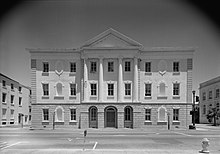
Hoban's Charleston County Courthouse, Charleston, South Carolina, 1790–92, was admired by Washington.
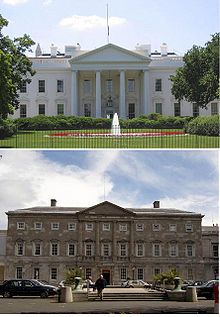
The North Portico of the White House compared to Leinster House
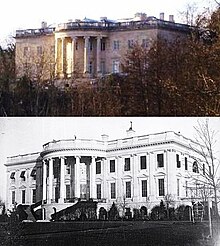
The Château de Rastignac compared to the South Portico of the White House, ca. 1846
President Washington visited Charleston, South Carolina, in May 1791 on his "Southern Tour", and saw the under-construction Charleston County Courthouse designed by Irish architect James Hoban. He is reputed to have met with Hoban then, and summoned the architect to Philadelphia and met with him there in June 1792.[6]
On July 16, 1792, the President met with the commissioners of the federal city to make his judgment in the architectural competition. His review is recorded as being brief, and he quickly selected Hoban's submission.[7]
Washington was not entirely pleased with the original submission, however; he found it too small, lacking ornament, and not monumental enough to house the nation's president. On his recommendation, the house was changed from three stories to two, and was widened from a nine-bay facade to an 11-bay facade. Hoban's competition drawings do not survive.
Design influences
The building Hoban designed is verifiably influenced by the upper floors of Leinster House, in Dublin, Republic of Ireland, which later became the seat of the Oireachtas (the Irish parliament).[8] Several other Georgian-era Irish country houses have been suggested as sources of inspiration for the overall floor plan, details like the bow-fronted south front, and interior details like the former niches in the present Blue Room. These influences, though undocumented, are cited in the official White House guide, and in White House Historical Association publications. The first official White House guide, published in 1962, suggested a link between Hoban's design for the South Portico and Château de Rastignac, a neoclassical country house located in La Bachellerie in the Dordogne region of France and designed by Mathurin Salat. Construction on the French house was initially started before 1789, interrupted by the French Revolution for twenty years and then finally built 1812–1817 (based on Salat's pre-1789 design).[9] The theoretical link between the two houses has been criticized because Hoban did not visit France. Supporters of a connection posit that Thomas Jefferson, during his tour of Bordeaux in 1789, viewed Salat's architectural drawings (which were on-file at the College) at the École Spéciale d'Architecture (Bordeaux Architectural College).[10] On his return to the U.S. he then shared the influence with Washington, Hoban, Monroe, and Benjamin Henry Latrobe.[9]Construction
Construction of the White House began with the laying of the cornerstone on October 13, 1792, although there was no formal ceremony.[11] The main residence, as well as foundations of the house, were built largely by enslaved and free African-American laborers, as well as employed Europeans.[12] Much of the other work on the house was performed by immigrants, many not yet with citizenship. The sandstone walls were erected by Scottish immigrants, employed by Hoban,[13] as were the high-relief rose and garland decorations above the north entrance and the "fish scale" pattern beneath the pediments of the window hoods. The initial construction took place over a period of eight years, at a reported cost of $232,371.83 (equal to $3,143,399 today). Although not yet completed, the White House was ready for occupancy on or circa November 1, 1800.[14]Shortages, including material and labor, forced alterations to the earlier plan developed by French engineer Pierre Charles L'Enfant for a "palace" that was five times larger than the house that was eventually built.[13] The finished structure contained only two main floors instead of the planned three, and a less costly brick served as a lining for the stone façades. When construction was finished, the porous sandstone walls were whitewashed with a mixture of lime, rice glue, casein, and lead, giving the house its familiar color and name.[13]
As it is a famed structure in America, several replicas of the White House have been constructed.
Architectural description
The principal facade of the White House, the north front, is of three floors and eleven bays. The ground floor is hidden by a raised carriage ramp and parapet, thus the facade appears to be of two floors. The central three bays are behind a prostyle portico (this was a later addition to the house, built circa 1830) serving, thanks to the carriage ramp, as a porte cochere. The windows of the four bays flanking the portico, at first-floor level, have alternating pointed and segmented pediments, while at second-floor level the pediments are flat. The principal entrance at the centre of the portico is surmounted by lunette fanlight. Above the entrance is a sculpted swag in relief. The roofline is hidden by a balustraded parapet.The mansion's southern facade is a combination of the Palladian and neoclassical styles of architecture. It is of three floors, all visible. The ground floor is rusticated in the Palladian fashion. At the centre of the facade is a neoclassical projecting bow of three bays. The bow is flanked by 5 bays, the windows of which, as on the north facade, have alternating segmented and pointed pediments at first-floor level. The bow has a ground floor double staircase leading to an Ionic colonnaded loggia (with the Truman Balcony at second-floor level), known as the south portico. The more modern third floor is hidden by a balustraded parapet and plays no part in the composition of the facade.
Naming conventions
The building was originally referred to variously as the "President's Palace", "Presidential Mansion", or "President's House".[15] The earliest evidence of the public calling it the "White House" was recorded in 1811.[16] A myth emerged that during the rebuilding of the structure after the Burning of Washington, white paint was applied to mask the burn damage it had suffered,[17] giving the building its namesake hue.[18] The name "Executive Mansion" was used in official contexts until President Theodore Roosevelt established the formal name by having "White House–Washington" engraved on the stationery in 1901.[19][20] The current letterhead wording and arrangement "The White House" with the word "Washington" centered beneath goes back to the administration of Franklin D. Roosevelt.[20]Although it was not completed until some years after the presidency of George Washington, it is also speculated that the name of the traditional residence of the President of the United States may have derived from Martha Washington's home, White House Plantation in Virginia, where the nation's first President had courted the First Lady in the mid-18th century.[21]
Evolution of the White House
Early use, the 1814 fire, and rebuilding
On Saturday, November 1, 1800, John Adams became the first president to take residence in the building.[13] During Adams' second day in the house, he wrote a letter to his wife Abigail, containing a prayer for the house. Adams wrote:Theodore Roosevelt had Adams's blessing carved into the mantel in the State Dining Room.[22]I pray Heaven to bestow the best of blessings on this House, and all that shall hereafter inhabit it. May none but honest and wise men ever rule under this roof.[22]
Adams lived in the house only briefly before Thomas Jefferson moved into the "pleasant country residence"[23] in 1801. Despite his complaints that the house was too big ("big enough for two emperors, one pope, and the grand lama in the bargain"[24]), Jefferson considered how the White House might be added to. With Benjamin Henry Latrobe, he helped lay out the design for the East and West Colonnades, small wings that help conceal the domestic operations of laundry, a stable and storage.[13] Today, Jefferson's colonnades link the residence with the East and West Wings.[13]
In 1814, during the War of 1812, the White House was set ablaze by British troops[25] during the Burning of Washington, in retaliation for burning Upper Canada's Parliament Buildings in the Battle of York; much of Washington was affected by these fires as well. Only the exterior walls remained, and they had to be torn down and mostly reconstructed because of weakening from the fire and subsequent exposure to the elements, except for portions of the south wall. Of the numerous objects taken from the White House when it was ransacked by British troops, only two have been recovered. Employees and slaves rescued a painting of George Washington,[25] and in 1939, a Canadian man returned a jewelry box to President Franklin D. Roosevelt, claiming that his grandfather had taken it from Washington. Some observers allege that most of these spoils were lost when a convoy of British ships led by HMS Fantome sank en route to Halifax off Prospect during a storm on the night of November 24, 1814,[26][27] even though Fantome had no involvement in that action.[28]
After the fire, President James Madison resided in The Octagon House from 1814 to 1815, and then the Seven Buildings from 1815 to the end of his term.[29] Meanwhile, both architect Benjamin Henry Latrobe and Hoban contributed to the design and oversight of the reconstruction, which lasted from 1815 until 1817. The south portico was constructed in 1824 during the James Monroe administration; the north portico was built six years later.[13] Though Latrobe proposed similar porticos before the fire in 1814, both porticos were built as designed by Hoban.[30] An elliptical portico at Château de Rastignac in La Bachellerie, France with nearly identical curved stairs is speculated as the source of inspiration due to its similarity with the South Portico,[31] although this matter is one of great debate.[32] Italian artisans, brought to Washington to help in constructing the U.S. Capitol, carved the decorative stonework on both porticos. Contrary to speculation, the North Portico was not modeled on a similar portico on another Dublin building, the Viceregal Lodge (now Áras an Uachtaráin, residence of the President of Ireland), for its portico postdates the White House porticos' design.[31] For the North Portico, a variation on the Ionic Order was devised incorporating a swag of roses between the volutes. This was done to link the new portico with the earlier carved roses above the entrance.
-
Jefferson and Latrobe's West Wing Colonnade in this nineteenth-century engraved view, is now the James S. Brady Press Briefing Room. -
Principal story plan for the white house by Benjamin Henry Latrobe, 1807. -
Earliest known photograph of the White House, taken c. 1846 by John Plumbe during the administration of James K. Polk.
Overcrowding and building the West Wing
By the time of the American Civil War, the White House had become overcrowded. The location of the White House was questioned, just north of a canal and swampy lands, which provided conditions ripe for malaria and other unhealthy conditions.[33] Brigadier General Nathaniel Michler was tasked to propose solutions to address these concerns. He proposed abandoning the use of the White House as a residence and designed a new estate for the first family at Meridian Hill in Washington, D.C., but Congress rejected the plan.[33]The Panic of 1873 had led to an economic depression that persisted through much of the decade. The Statue of Liberty project was not the only undertaking that had difficulty raising money: construction of the obelisk later known as the Washington Monument sometimes stalled for years.[34]
When Chester Arthur took office in 1881, he ordered renovations to the White House to take place as soon as the recently widowed Lucretia Garfield moved out. Arthur inspected the work almost nightly and made several suggestions. Louis Comfort Tiffany was asked to send selected designers to assist. Over twenty wagons of furniture and household items were removed from the building and sold at a public auction.[35] All that was saved were bust portraits of John Adams and Martin Van Buren.[36] A proposal was made to build a new residence south of the White House, but it failed to gain support. In the fall of 1882 work was done on the main corridor, including tinting the walls pale olive and adding squares of gold leaf, and decorating the ceiling in gold and silver, and colorful traceries woven to spell "USA". The Red Room was painted a dull Pomeranian red, and its ceiling was decorated with gold, silver, and copper stars and stripes of red, white, and blue. A fifty-foot jeweled Tiffany glass screen, supported by imitation marble columns, replaced the glass doors that separated the main corridor from the north vestibule.[37]
In 1891, First Lady Caroline Harrison proposed major extensions to the White House, including a National Wing on the east for an historical art gallery, and a wing on the west for official functions.[33] A plan was devised by Colonel Theodore A. Bingham, which reflected the Harrison proposal.[33] These plans were ultimately rejected. However, in 1901 Theodore Roosevelt and his family moved into the White House and hired McKim, Mead & White to carry out renovations and expansion, including the addition of a West Wing.[13] (McKim designed and managed the project.) President William Howard Taft enlisted the help of architect Nathan C. Wyeth to add additional space to the West Wing, which included the addition of the Oval Office.[33]
The West Wing was damaged by fire in 1929, but rebuilt during the remaining years of the Herbert Hoover presidency. In the 1930s, a second story was added, as well as a larger basement for White House staff, and President Franklin Roosevelt had the Oval Office moved to its present location: adjacent to the Rose Garden.[13]
The Truman reconstruction

Truman reconstruction, 1949–1952, a steel structure is built within the exterior shell
The Kennedy restoration
Jacqueline Kennedy, wife of President John F. Kennedy (1961–63), directed a very extensive and historic redecoration of the house. She enlisted the help of Henry Francis du Pont of the Winterthur Museum to assist in collecting artifacts for the mansion, many of which had once been housed there.[42] Other antiques, fine paintings, and improvements of the Kennedy period were donated to the White House by wealthy philanthropists, including the Crowninshield family, Jane Engelhard, Jayne Wrightsman, and the Oppenheimer family. Stéphane Boudin of the House of Jansen, a Paris interior-design firm that had been recognized worldwide, was employed by Mrs. Kennedy to assist with the decoration.[42] Different periods of the early republic and world history were selected as a theme for each room: the Federal style for the Green Room, French Empire for the Blue Room, American Empire for the Red Room, Louis XVI for the Yellow Oval Room, and Victorian for the president's study, renamed the Treaty Room. Antique furniture was acquired, and decorative fabric and trim based on period documents was produced and installed. The Kennedy restoration resulted in a more authentic White House of grander stature, which recalled the French taste of Madison and Monroe.[42] In the Diplomatic Reception Room Mrs. Kennedy installed an antique "Vue de l'Amérique Nord" wall paper which Zuber & Cie had designed in 1834. The wallpaper had hung previously on the walls of another mansion until 1961 when that house was demolished for a grocery store. Just before the demolition, the wallpaper was salvaged and sold to the White House.The first White House guidebook was produced under the direction of curator Lorraine Waxman Pearce with direct supervision from Mrs. Kennedy.[43] Sale of the guidebook helped finance the restoration.
The White House since the Kennedy restoration
Out of respect for the historic character of the White House, no substantive architectural changes have been made to the house since the Truman renovation.[44] Since the Kennedy restoration, every presidential family has made some changes to the private quarters of the White House, but the Committee for the Preservation of the White House must approve any modifications to the State Rooms. Charged with maintaining the historical integrity of the White House, the congressionally authorized committee works with each First Family—usually represented by the First Lady, the White House Curator, and the Chief Usher—to implement the family's proposals for altering the house.[45]During the Nixon administration (1969–74), First Lady Pat Nixon refurbished the Green Room, Blue Room, and Red Room, working with Clement Conger, the curator appointed by President Richard Nixon.[46] Mrs. Nixon's efforts brought more than 600 artifacts to the house, the largest acquisition by any administration.[47] Her husband created the modern press briefing room over Franklin Roosevelt's old swimming pool.[48] Nixon also added a single-lane bowling alley to the White House basement.[49]
Computers and the first laser printer were added during the Carter administration, and the use of computer technology was expanded during the Reagan administration.[50] A Carter-era innovation, a set of solar water heating panels that were mounted on the roof of the White House, was removed during Reagan's presidency.[51][52] Redecorations were made to the private family quarters and maintenance was made to public areas during the Reagan years.[53] The house was accredited as a museum in 1988.[53]
In the 1990s, Bill and Hillary Clinton refurbished some rooms with the assistance of Arkansas decorator Kaki Hockersmith, including the Oval Office, the East Room, Blue Room, State Dining Room, Lincoln Bedroom, and Lincoln Sitting Room.[54] During the administration of George W. Bush, first lady Laura Bush refurbished the Lincoln Bedroom in a style contemporary to the Lincoln era; the Green Room, Cabinet Room, and theater were also refurbished.[54]
The White House became one of the first wheelchair-accessible government buildings in Washington when modifications were made during the presidency of Franklin D. Roosevelt, who used a wheelchair because of his paralytic illness. In the 1990s, Hillary Rodham Clinton—at the suggestion of Visitors Office Director Melinda N. Bates—approved the addition of a ramp in the East Wing corridor. It allowed easy wheelchair access for the public tours and special events that enter through the secure entrance building on the east side.
The president usually travels to and from the White House grounds via official motorcade or helicopter. In the 1950s, President Dwight D. Eisenhower was the first president to travel by helicopter to and from the White House grounds.[55]
Layout and amenities
Today the group of buildings housing the presidency is known as the White House Complex. It includes the central Executive Residence flanked by the East Wing and West Wing. The Chief Usher coordinates day to day household operations. The White House includes: six stories and 55,000 ft² (5,100 m²) of floor space, 132 rooms and 35 bathrooms, 412 doors, 147 windows, twenty-eight fireplaces, eight staircases, three elevators, five full-time chefs, a tennis court, a (single-lane) bowling alley, a movie theater (officially called the White House Family Theater[56]), a jogging track, a swimming pool, and a putting green.[20] It receives up to 30,000 visitors each week.[57]Executive Residence
Main article: Executive Residence
The original residence is in the center. Two colonnades—one on the east and one on the west—designed by Jefferson, now serve to connect the East and West Wings, added later. The Executive Residence
houses the president's dwelling, as well as rooms for ceremonies and
official entertaining. The State Floor of the residence building
includes the East Room, Green Room, Blue Room, Red Room, State Dining Room, Family Dining Room, Cross Hall, Entrance Hall, and Grand Staircase.[58] The Ground Floor is made up of the Diplomatic Reception Room, Map Room, China Room, Vermeil Room, Library, the main kitchen, and other offices.[59] The second floor family residence includes the Yellow Oval Room, East and West Sitting Halls, the White House Master Bedroom, President's Dining Room, the Treaty Room, Lincoln Bedroom and Queens' Bedroom, as well as two additional bedrooms, a smaller kitchen, and a private dressing room.[60]
The third floor consists of the White House Solarium, Game Room, Linen
Room, a Diet Kitchen, and another sitting room (previously used as
President George W. Bush's workout room).[61]West Wing
Main article: West Wing
The West Wing houses the President's office (the Oval Office) and offices of his senior staff, with room for about 50 employees. It also includes the Cabinet Room, where the president conducts business meetings and where the Cabinet meets,[62] as well as the White House Situation Room, James S. Brady Press Briefing Room, and Roosevelt Room.[63] In 2007, work was completed on renovations of the press briefing room, adding fiber optic cables and LCD screens for the display of charts and graphs.[64] The makeover took 11 months and cost $8 million, of which news outlets paid $2 million.[64] In September 2010, a two-year project began on the West Wing, creating a multistory underground structure;[65] this will be followed with additional renovation of the wing.[66] Some members of the President's staff are located in the adjacent Old Executive Office Building, formerly the State War and Navy building, and sometimes known as the Eisenhower Executive Office Building.[64]This portion of the building was used as the setting for the popular television show The West Wing.
East Wing
Main article: East Wing
The East Wing, which contains additional office space, was added to
the White House in 1942. Among its uses, the East Wing has
intermittently housed the offices and staff of the First Lady, and the White House Social Office. Rosalynn Carter,
in 1977, was the first to place her personal office in the East Wing
and to formally call it the "Office of the First Lady". The East Wing
was built during World War II in order to hide the construction of an underground bunker to be used in emergencies. The bunker has come to be known as the Presidential Emergency Operations Center.Grounds
The White House and grounds cover just over 18 acres (about 7.3 hectares). Before the construction of the North Portico, most public events were entered from the South Lawn, which was graded and planted by Thomas Jefferson. Jefferson also drafted a planting plan for the North Lawn that included large trees that would have mostly obscured the house from Pennsylvania Avenue. During the mid-to-late 19th century a series of ever larger green houses were built on the west side of the house, where the current West Wing is located. During this period, the North Lawn was planted with ornate carpet-style flowerbeds. Although the White House grounds have had many gardeners through their history, the general design, still largely used as master plan today, was designed in 1935 by Frederick Law Olmsted, Jr. of the Olmsted Brothers firm, under commission from President Franklin D. Roosevelt. During the Kennedy administration, the White House Rose Garden was redesigned by Rachel Lambert Mellon. The Rose garden borders the West Colonnade. Bordering the East Colonnade is the Jacqueline Kennedy Garden, which was begun by Jacqueline Kennedy but completed after her husband's assassination. On the weekend of June 23, 2006, a century-old American Elm (Ulmus americana L.) tree on the north side of the building, came down during one of the many storms amid intense flooding. Among the oldest trees on the grounds are several magnolias (Magnolia grandiflora) planted by Andrew Jackson. Michelle Obama planted the White Houses' first organic garden and installed beehives on the South Lawn of the White House, which will supply organic produce and honey to the First Family and for state dinners and other official gatherings.[67]-
The Cross Hall, connecting the State Dining Room and the East Room on the State Floor. -
Marine One prepares for landing on the South Lawn where State Arrival Ceremonies for visiting heads of state take place -
Yellow Oval Room in the private, second-floor family residence centered directly above the Blue Room.















